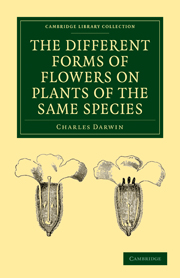Book contents
- Frontmatter
- Contents
- INTRODUCTION
- CHAPTER I HETEROSTYLED DIMORPHIC PLANTS: PRIMTULACEÆ
- CHAPTER II HYBRID PRIMULAS
- CHAPTER III HETEROSTYLED DIMORPHIC PLANTS–continued.
- CHAPTER IV HETEROSTYLED TRIMORPHIC PLANTS
- CHAPTER V ILLEGITIMATE OFFSPRING OF HETEROSTYLED PLANTS
- CHAPTER VI CONCLUDING REMARKS ON HETEROSTYLED PLANTS
- CHAPTER VII POLYGAMOUS, DIŒCTOUS, AND GYNO-DIŒCIOUS PLANTS
- CHAPTER VIII CLEISTOGAMIO FLOWERS
- INDEX
CHAPTER VI - CONCLUDING REMARKS ON HETEROSTYLED PLANTS
Published online by Cambridge University Press: 05 July 2011
- Frontmatter
- Contents
- INTRODUCTION
- CHAPTER I HETEROSTYLED DIMORPHIC PLANTS: PRIMTULACEÆ
- CHAPTER II HYBRID PRIMULAS
- CHAPTER III HETEROSTYLED DIMORPHIC PLANTS–continued.
- CHAPTER IV HETEROSTYLED TRIMORPHIC PLANTS
- CHAPTER V ILLEGITIMATE OFFSPRING OF HETEROSTYLED PLANTS
- CHAPTER VI CONCLUDING REMARKS ON HETEROSTYLED PLANTS
- CHAPTER VII POLYGAMOUS, DIŒCTOUS, AND GYNO-DIŒCIOUS PLANTS
- CHAPTER VIII CLEISTOGAMIO FLOWERS
- INDEX
Summary
In the foregoing chapters all the heterostyled plants known to me have been more or less fully described. Several other cases have been indicated, especially by Professor Asa Gray and Kuhn, in which the individuals of the same species differ in the length of their stamens and pistils; but as I have been often deceived by this character taken alone, it seems to me the more prudent course not to rank any species as heterostyled, unless we have evidence of more important differences between the forms, as in the diameter of the pollen-grains, or in the structure of the stigma. The individuals of many ordinary hermaphrodite plants habitually fertilise one another, owing to their male and female organs being mature at different periods, or to the structure of the parts, or to self-sterility, &c.; and so it is with many hermaphrodite animals, for instance, land-snails or earth-worms ; but in all these cases any one individual can fully fertilise or be fertilised by any other individual of the same species. This is not so with heterostyled plants: a long-styled, mid-styled or short-styled plant cannot fully fertilise or be fertilised by any other individual, but only by one belonging to another form. Thus the essential character of plants belonging to the heterostyled class is that the individuals are divided into two or three bodies, like the males and females of dioecious plants or of the higher animals, which exist in approximately equal numbers and are adapted for reciprocal fertilisation.
- Type
- Chapter
- Information
- The Different Forms of Flowers on Plants of the Same Species , pp. 244 - 277Publisher: Cambridge University PressPrint publication year: 2010First published in: 1877
- 1
- Cited by



